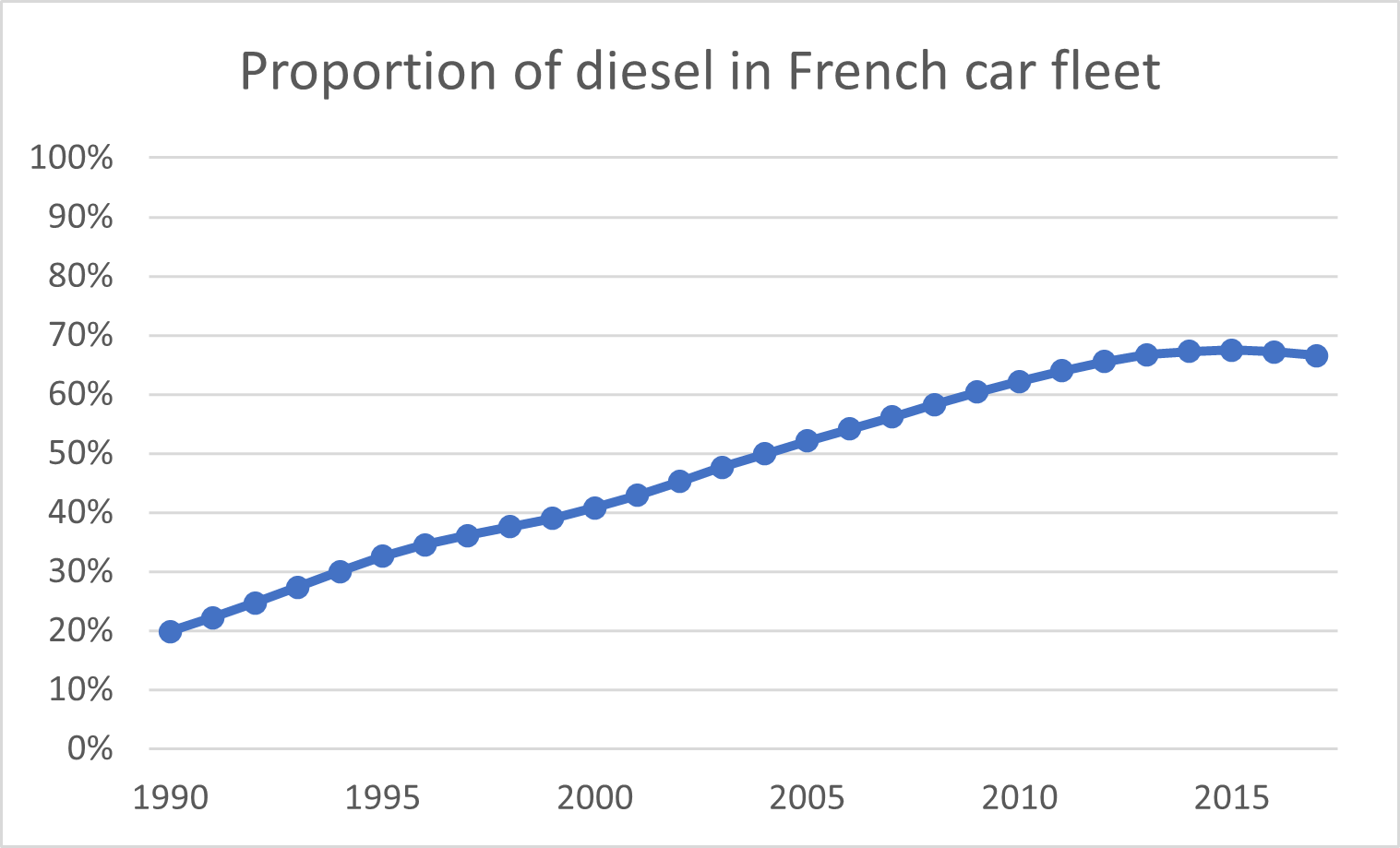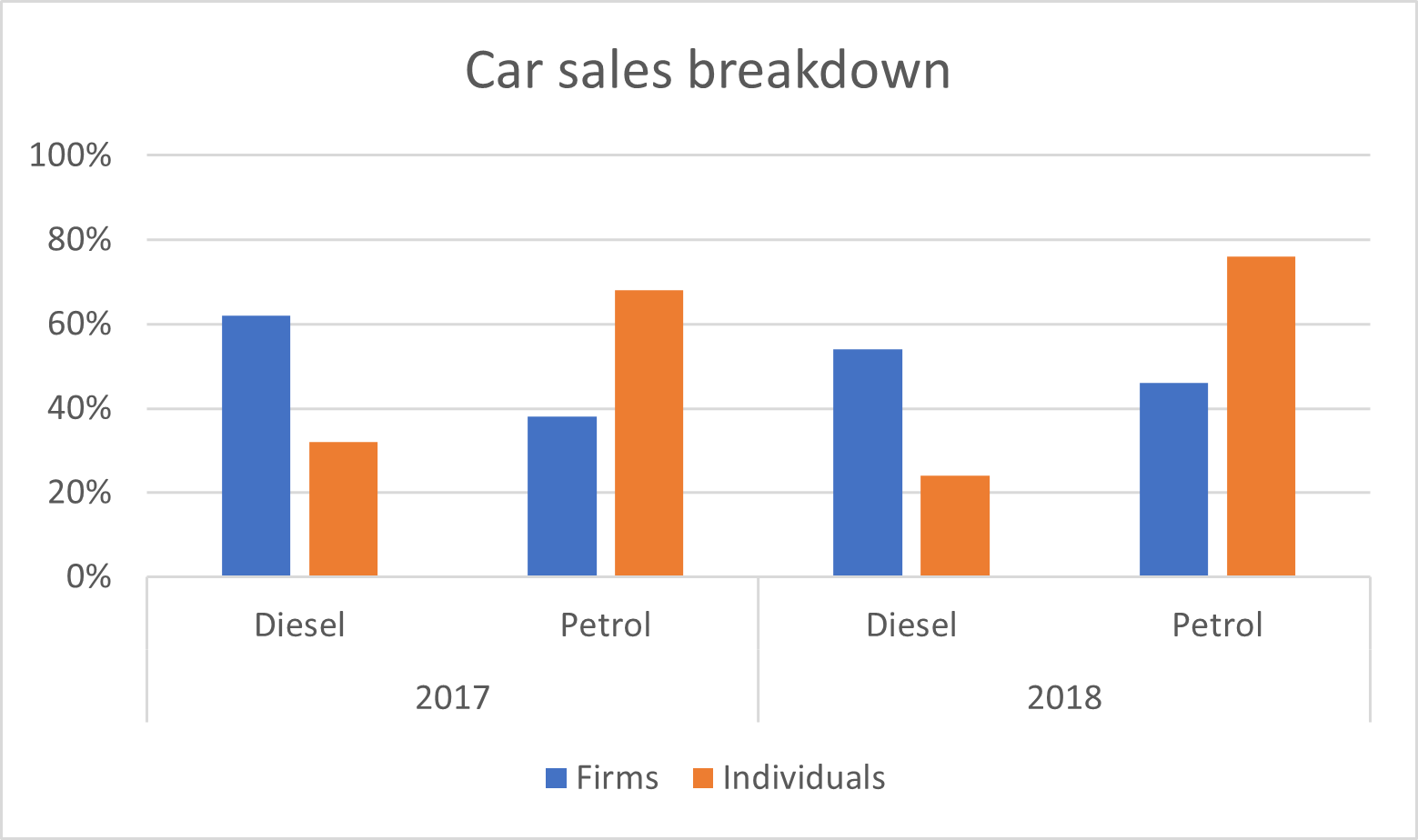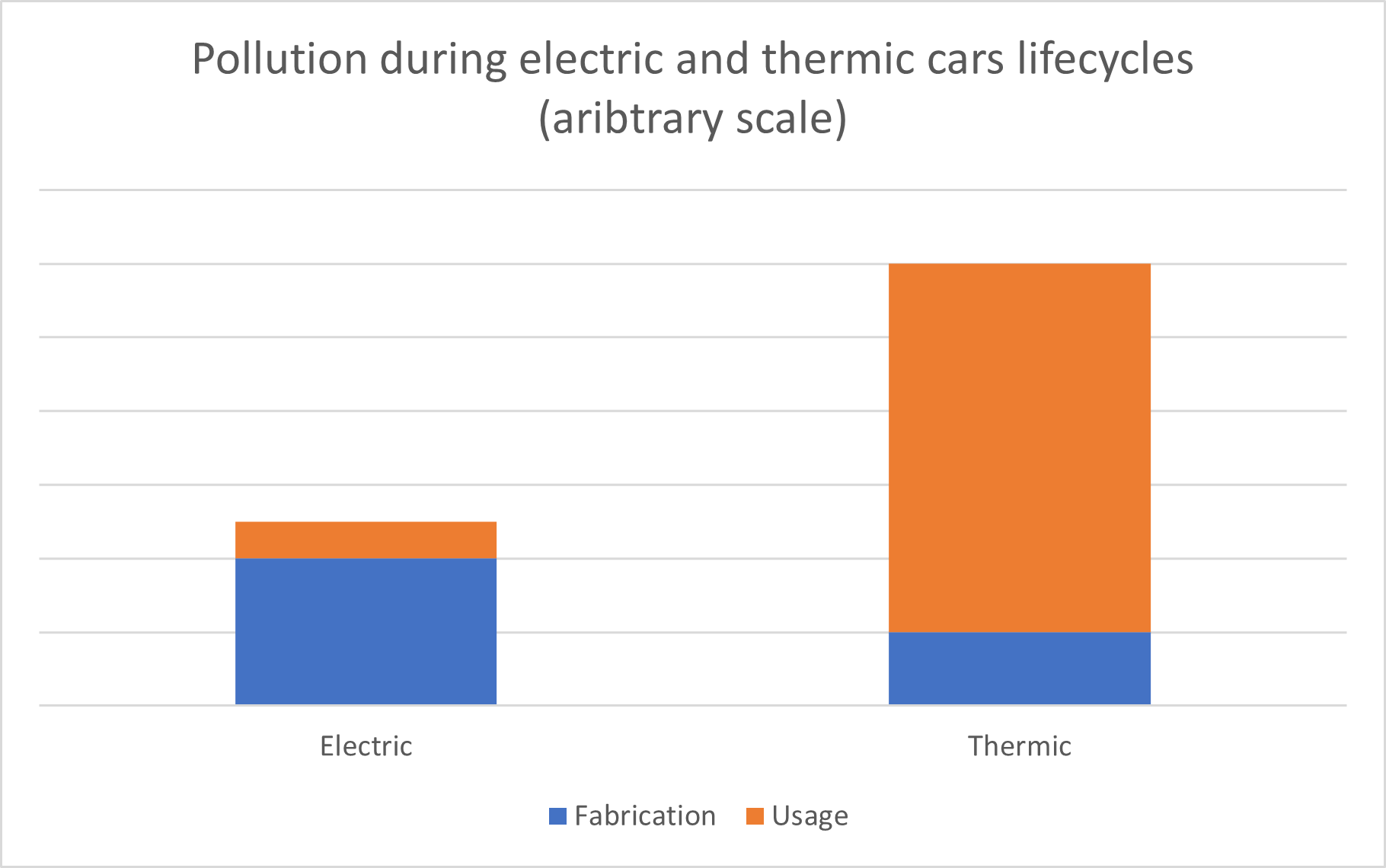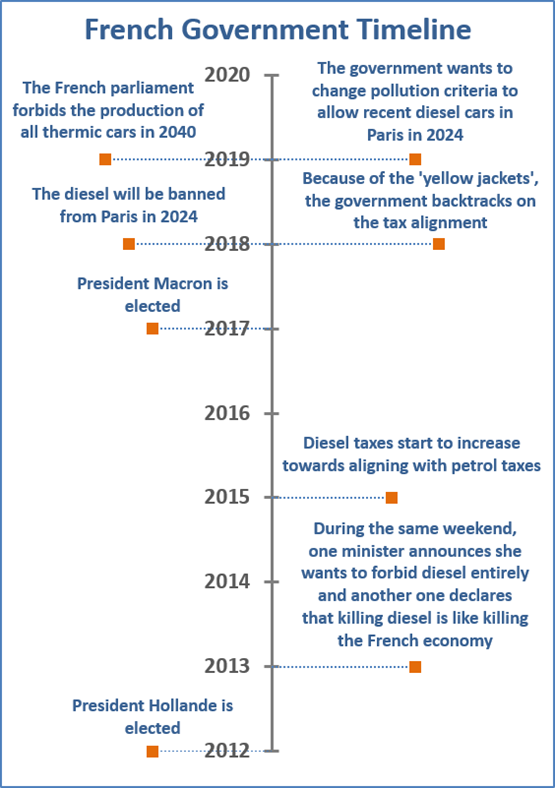After WWII, Charles de Gaulle jumpstarted the French economy by cutting diesel taxes for the first time, supporting haulers, farmers, and artisans who relied on it.
Later, in 1980, Toyota and its revolutionary production model flooded the French market with economical and reliable cars. At the same time, France replaced all its diesel-based power plants with nuclear ones to ensure energy independence. The French government also introduced new diesel incentives to boost the competitive advantage of local manufacturers specializing in diesel engines and to dispose of the million litres of now-useless diesel from power plants.
Today, 61% of cars in France run on diesel (INSEE, 2018), one of the highest proportions in the European Union. This situation generates significant environmental and public health issues. Indeed, diesel engines emit more fine particulate matter (PM) than their petrol counterparts, thereby increasing air pollution and potentially contributing to an increased risk of lung cancer.
According to the (European Commission, 2015) and (Anenberg, et al., 2017), around 10,000 people die annually in France because of diesel. Furthermore, air pollution costs the country 100 billion euros each year (Aichi, 2015). The European Commission is also currently investigating eleven French cities for exceeding authorized pollution thresholds.
In response to this long-standing crisis, the government sought to reduce incentives by aligning diesel and gasoline taxation. This measure became the tipping point for the French public, renowned for their spirit of revolt, who erupted into the Yellow Vest movement. For seven months, the protests have rocked one of the world’s most powerful economies.
This document aims to analyze the role played by incentives in this crisis, explore what could have been done differently, and provide potential solutions to address the current situation.
Situation Analysis
After the war, de Gaulle’s incentive smoothed the business cycle when the economy was at its weakest (as theorized by Keynes). The incentive was well-calibrated as it benefited businesses without significantly altering private consumers’ behaviour. After the 1973 oil shock, diesel cars became increasingly appealing to individuals due to their lower fuel consumption. French manufacturers seized this opportunity to invest in this technology.

Figure 1. – Source: (L'Argus, 2015)
In 1980, Toyota was dominating the competition thanks to its exemplary production model, heavily influenced by statistician W. Edwards Deming. In response, the French government once again reduced diesel fuel taxation and introduced VAT deductions for businesses to strengthen domestic manufacturers’ competitive advantage, namely their expertise in diesel engines. As a result, the proportion of diesel vehicles in France tripled between 1980 and 1990, while it only doubled across the rest of Europe (see Figure 1). French consumers made what appeared to be the most rational decision from a financial standpoint. However, the opportunity cost, their health, was huge and largely overlooked. This suboptimal decision undoubtedly resulted from information asymmetry: the general public was not fully aware of the dangers associated with diesel.
During the 2000s, manufacturers marketed diesel as a form of ‘clean energy’, claiming it produced fewer greenhouse gas (GHG) emissions than petrol (BP, 2000). These marketing campaigns, combined with technological advances that made more powerful diesel engines, drove a surge in sales that remained steady until 2012. After that, growing awareness of PM led to the introduction of new regulations (e.g., Euro 6) and a reduction in tax incentives for individual consumers. As a result, the cost of owning a diesel vehicle rose, diminishing its value relative to petrol-based models. In 2015, the ‘Dieselgate’ scandal was the final nail in the coffin for diesel vehicles.
The last two decades have left the country with a large number of diesel cars in circulation (see Figure 2). Consequently, many people remain dependent on this fuel, leaving the government with limited room to ease the transition toward less harmful vehicles. Meanwhile, lobbying groups and diesel-dependent corporations push back against every attempt to reduce incentives, threatening to suppress jobs and potentially leading to strikes that could bring the country to a standstill. For this reason, company incentives persist and remain highly attractive (see Figure 3).
In this context, the government struggles to offer a clear vision of the issue (see Appendix 1: French Government Timeline). Unfortunately, the ongoing uncertainties and mixed signals surrounding diesel and combustion-engine cars do not foster an environment in which consumers can make informed decisions, especially when purchasing a new vehicle.
Considering the information above, one might wonder whether the French government made the right decision in the 1980s. It arguably saved the French car industry, but at what cost? The government was, in fact, already aware of the adverse effects of diesel. A 1983 report (Roussel, 1983) outlined the risks associated with diesel-powered engines and even recommended halting their production.
Moreover, Toyota was not winning the market due to unfair advantages, such as cheap labour. Instead, the company’s focus on understanding variation and its continuous improvement mindset enabled it to reduce waste and consistently produce high-quality cars at lower costs (The Deming Institute, 2007). In contrast, the French government attempted to regulate the economy, disrupting the signals that consumers and firms were sending to one another (what Adam Smith famously referred to as the ‘invisible hand’). As Hayek predicted, this interventionism proved inefficient. Furthermore, the government’s primary objective was to apply a form of protectionism. This policy approach limited product variety for consumers and prevented companies from reaching their full potential in the absence of competitive pressure.
Had the government allowed competition to take its course, French manufacturers would have either improved their quality and performance or closed down. In both cases, consumers would have ended up with better and more affordable cars. As for employment, Toyota would likely have created new jobs in France, offsetting those lost (as occurred in 2001, when it opened its factory in Valenciennes).

Figure 2. – Source: (INSEE, 2018)

Figure 3. – Source: (Auto BFM, 2018)
Assessment of Potential Solutions
As discussed above, the current situation is complex. Most government actions to address the issue have proved ineffective or, worse, led to adverse economic outcomes (e.g., the Yellow Vest movement). This section aims to assess existing initiatives and propose potential solutions for the future. Punitive incentives have been set aside, as they risk deepening inequalities by giving wealthier individuals the so-called ‘right’ to pollute while further pauperizing the population, already under strain.
Expanding incentives for petrol
Since raising diesel taxes to match petrol taxes is not a viable option, an alternative could be to extend all diesel-related incentives to petrol. The French government has partially adopted this approach and plans to implement it for businesses’ VAT deductions by 2022.
This alternative would remove diesel-specific incentives while increasing the purchasing power of petrol car owners. In turn, the market would adjust, leading to a decrease in the proportion of diesel vehicles. Subsequently, the government could phase out both incentives gradually and equitably.
On the other hand, this approach could also encourage individuals with tight petrol-related budget constraints to consume more. According to the ‘income effect’, for a constant income, a price decrease loosens budget constraints, potentially increasing consumption. Given the growing scarcity of oil and the urgency of global warming, this type of incentive is unsustainable in the long term. Still, it could represent a reasonable short-term trade-off.
Providing subsidies to change old vehicles
Providing subsidies to replace old diesel cars with new, cleaner, non-diesel ones is another potential solution. These subsidies already exist in France, but they are insufficient to support low-income individuals, who are more likely to own older, more polluting vehicles. Moreover, the system creates a perverse incentive: since the subsidy amount depends on the CO2 emissions of the new vehicle, many people use it to purchase another diesel car.
An alternative would be to increase the subsidy amount for those who need it most while reducing it for higher-income individuals. In addition, all pollutant particles (e.g., PM) should be considered, not just CO2. Given the previously mentioned cost of air pollution, a well-calibrated mechanism could be both economically viable and beneficial to the country’s public health.
Encouraging electric vehicles
Electric cars are not as clean as they may seem: their manufacturing process generates roughly twice as much pollution as that of combustion-engine vehicles. The battery is the primary source of emissions, as it requires rare earth elements, whose extraction demands large quantities of water and chemicals. As a result, pollution is often outsourced to developing countries such as China or Brazil.
However, over their full lifecycle, electric cars emit two to three times fewer GHG and PM than combustion-engine vehicles (see Figure 4). Moreover, technological progress is expected to reduce reliance on rare earths for batteries and enhance their recycling process (SAFT, 2018).

Figure 4. – Source: (EEA, 2018)
France’s electricity production — mainly nuclear (72%) and hydroelectric (12%) — generates very low levels of GHG and PM. Therefore, the country is well-positioned to leverage the environmental benefits of electric vehicles. Moreover, France provides subsidies that make electric cars nearly as affordable as combustion-engine models.
Soon, more competitive prices and greater utility (e.g., longer range and shorter charging times) will enhance the value of electric vehicles for consumers. Consequently, future demand, social desirability, and improved technology will shift the supply curve, reducing the share of combustion-engine cars in manufacturers’ sales mixes.
Reducing the need for cars
So far, governments and manufacturers have addressed the symptoms rather than the underlying causes of the problem. It’s like prescribing aspirin to relieve headaches caused by meningitis — a short-term fix that can lead to serious complications, such as kidney disease, over time. So why not shift the entire paradigm? The idea is to remove cars from urban centres to improve air quality and public health. Indeed, traffic congestion is one of the primary contributors to air pollution (Hermes, 2012).
Introduced in the 1980s in California, ‘walkable communities’ are an emerging model in urban planning. These are self-contained neighbourhoods that allow residents to live, work and enjoy leisure activities within walking distance. They are also supported by efficient public transit systems that link them to the broader city.
Extensive studies have demonstrated that these areas provide significant social, health, and safety benefits (Talen & Koschinsky, 2014). They also bring measurable economic value by boosting local business activity, generating employment and encouraging consumer spending (Bent & Singa, 2008). Once established, walkable neighbourhoods require minimal upkeep from municipalities, especially when compared to the long-term costs of car infrastructure, including policing, emergency services, and maintenance. Millennials, who now represent around 62% of the population, prefer to live in places where owning a car isn’t necessary (Mundahl, 2018), and their preferences are already shifting demand in favour of this urban model. Several cities, including Taipei, Paris, Mexico City, and Cairo, have announced plans to develop walkable cities, signalling a global shift toward healthier, more sustainable urban living (see Figure 5).

Figure 5. Paris Smart City Project
Conclusion
Economic interventionism can profoundly affect a country’s direction, and not only on an economic level. That’s why governments should adopt a systemic approach when evaluating the relevance of incentives and take steps to prevent unintended consequences. France’s relationship with diesel policy offers a revealing case study, as it clearly illustrates how seemingly similar policies can lead to radically different outcomes.
In the post-war context, lower diesel taxation played a significant role in the revival of the French economy. At the same time, it made sense for the government to absorb investment risk: infrastructure was in ruins, and the future was uncertain (the country had endured two wars in just thirty years).
In the 1980s, the country’s economy was once again under strain, but the context was entirely different. This time, the government turned to protectionism to shield French manufacturers from foreign competition. While such measures might have been justified in the face of unfair competition (e.g., social, environmental or fiscal dumping), in this case — a regular market economy — they led to lost efficiency, health issues, and other adverse outcomes.
Today, government intervention is necessary again, but for a different reason: the country is facing a market failure due to negative externalities from polluting production and consumption. Indeed, environmental and health costs are not reflected in market prices, and future policy solutions should internalize these externalities.
This analysis also shows that traditional economic theories (e.g., Keynes, Friedman, or Hayek views) can all be valid, depending on the circumstances. Economic decision-makers should resist the temptation to view the world through a single lens. There is no silver bullet — only context, adaptability, and the courage to correct course.
Appendices
Appendix 1: French Government Timeline

Appendix 1: French government timeline
Sources
- Aichi, L. (2015). Pollution de l’air : le coût de l’inaction. Sénat, Paris.
- Anenberg, S., Miller, J., Minjares, R., Du, L., Henze, D., Lacey, F., . . . Heyes, C. (2017, May 25). Impacts and mitigation of excess diesel NOx emissions in 11 major vehicle markets. Nature(545), 467-471.
- Auto BFM. (2018, October 20). Qui achète encore des voitures diesel en France? Retrieved from BFM TV: https://auto.bfmtv.com/actualite/qui-achete-encore-des-voitures-diesel-en-france-1548163.html
- Bent, E. M., & Singa, K. (2008). Modal Choices and Spending Patterns of Travelers to Downtown San Francisco: Impacts of Congestion Pricing on Retail Trade. San Francisco.
- BP. (2000). Diesel ecology: Voiture disparue. Retrieved from INA: http://player.ina.fr/player/embed/PUB2346204085/1/1b0bd203fbcd702f9bc9b10ac3d0fc21/450/300/0/148db8
- EEA. (2018). Electric vehicles from a life cycle and circular economy perspective. European Environment Agency.
- European Commission. (2015). Cleaner air for all. Retrieved from European Commission: http://ec.europa.eu/environment/air/cleaner_air/
- Hermes, J. (2012, January 5). How Traffic Jams Affect Air Quality. Retrieved from Environmental Leader: https://www.environmentalleader.com/2012/01/how-traffic-jams-affect-air-quality/
- INSEE. (2018, October 24). Véhicules en service en 2017. Retrieved from INSEE: https://www.insee.fr/fr/statistiques/2045167
- L’Argus. (2015, February 15). Infographies : état des lieux du marché du diesel en France. Retrieved from L’Argus.fr: https://www.largus.fr/actualite-automobile/infographies-etat-des-lieux-du-marche-du-diesel-en-france-5955384.html
- Mundahl, E. (2018, February 7). Walkable cities are where people want to live, and spend. Retrieved from South Florida Sun Sentinel: https://www.sun-sentinel.com/opinion/fl-op-walkable-cities-popularity-20180207-story.html
- Roussel, A. (1983). Impact médical des pollutions d’origine automobile. French Ministry of Health, French Ministry for the Environment, Paris.
- SAFT. (2018, June 29). Trois technologies de batterie qui pourraient révolutionner notre futur. Retrieved from SAFT Batteries: https://www.saftbatteries.com/fr/media-resources/our-stories/trois-technologies-de-batterie-qui-pourraient-revolutionner-notre-futur
- Talen, E., & Koschinsky, J. (2014). Compact, Walkable, Diverse Neighborhoods: Assessing Effects on Residents. Housing Policy Debate, 24(4), 717-750.
- The Deming Institute. (2007). W. Edwards Deming: Prophet Unheard. Retrieved from YouTube: https://www.youtube.com/watch?v=GHvnIm9UEoQ
